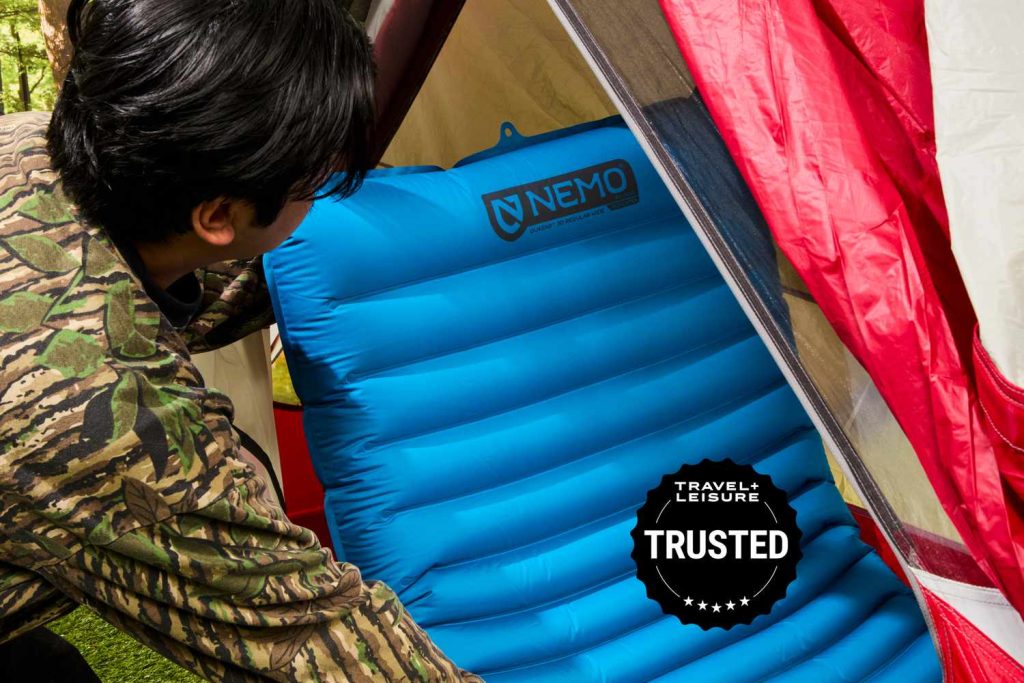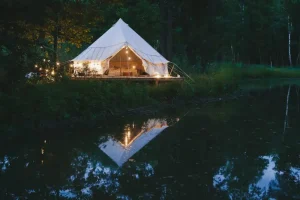A sleeping pad is a critical part of your outdoor sleep system even if it may be something we often forget. Sure, everyone knows to pack a cozy sleeping bag when you’re going camping, but without a sleeping pad to protect from the ground, your sleeping bag can lose a lot of its warmth — forget the misery of feeling rocks and roots digging into your back.
These days, sleeping pads can be warm enough for cold nights, but still pack down to about the size of a water bottle, and many inflate with just a few breaths. I’m a seasoned camper, and I sleep better on some of my backpacking sleeping pads than I do at home. We tested the best options out there in our New York City lab and across the country on real camping trips to find the best sleeping pads that are guaranteed to elevate your camping experience.
What is the difference between a sleeping pad and camping air mattress?
While the two terms are often used interchangeably, a sleeping pad is lightweight (sometimes less than one pound), packable, and is made for carrying into the backcountry on long trips. A camping air mattress, on the other hand, is a more plush, heavier inflatable mattress that keeps you off the ground while front-country camping (or keeps your houseguests off the floor).
I use an air mattress for houseguests, car camping, or when weight doesn’t matter on road trips when I’m planning on sleeping in my truck bed. Conversely, I use a sleeping pad for backpacking and bikepacking trips when weight really matters. Most of the sleeping pads on this list weigh just one or two pounds and pack down to the size of a standard toiletry bag.
After hundreds of nights sleeping outdoors on a variety of camping mattresses, our thru-hiking tester discovered this sleeping pad and stuck with it. It inflates in just 10 breaths, and though it has less height than others, we actually found it to be one of the most comfortable for sleeping. Instead of a bouncy, trampoline-like feeling, Sea to Summit uses their proprietary AirSprung cells that conform to your body. This means that side sleepers or people with bony hips might feel the ground underneath them, but the added ThermoLite insulation in the air pockets helps counter this with added warmth and cushion.
The unisex version has a 3.1 R-value, which is more than warm enough for three-season camping, and we’ve even used it during more moderate winter overnights when paired with a winter-ready sleeping bag. Finally, this sleeping pad also gets top marks for the adjustability, using the brand’s reliable flat-lock air valve that can be minutely adjusted for different inflation levels, and deflates in just a few seconds. It’s also one of the most durable sleeping pads we’ve tested — our tester has had hers for four seasons of consistent use and has yet to put a hole in the fabric or strain any of the welded seams.
The Details: 72 x 21.5 x 2 inches inflated | 9 x 4 inches packed | 1.56 pounds | 3.1 R-value | 30D/40D Nylon
Nemo has put a strong emphasis on sustainability over the past few seasons, and this sleeping pad is just another addition to a lineup of camping gear you can feel good about purchasing. The materials include Bluesign-approved, recycled fabrics and the insulated versions of this sleeping pad use recycled PCR PrimaLoft. Nemo uses a lie-flat valve with micro-adjustments so you can deflate to your preferred level. It took us a few tries to get used to the inflation system, but we were grateful to save the breath using their included air-seal bag. We were impressed with the support for all of our sleeping positions, and even when we rolled onto our side and felt the mattress dip, the inflation evened out and we never felt like we were hitting the ground.
The Details: 72 x 25 x 4 inches inflated | 9 x 5 inches packed | 1.56 pounds | 3.3 R-value | Polyester and PrimaLoft insulation
Sometimes you just don’t want to blow up a mattress when you get to camp, but you also don’t want to sleep on a hard chunk of closed-cell foam. Enter the self-inflating mattress. Typically a little on the heavier side, these mattresses make up for the extra weight and larger packed size with convenience. This sleeping pad has an incredibly fast inflation that set up with just one valve twist. We did have to top it off with a few breaths, but the majority of the air went in automatically and we could stay busy with other chores while it worked its magic. We weren’t sure about the density and comfort of this pad, as the height is just two inches and seemed pretty thin, but we were pleasantly surprised by how supportive the foam-and-air combo was, and the wider dimensions felt perfectly spacious for one person.
The Details: 77 x 25 x 2 inches inflated | 21 x 8.5 inches packed | 2.5 pounds | 6 R-value | Polyester and foam
Sea to Summit’s Ether Lite XT uses AirSprung cells and a flat-lock adjustable valve for comfort and ease of inflation. It’s slightly larger and weighs a few more ounces than the Ultralight version, but if you want a bump in R-value and the added inches, this is a solid pick. It has a durable dual-denier nylon, with 40-denier on the bottom and 30-denier on the top.
While we wouldn’t throw this down on top of a cactus (don’t ask us how we know this) we have taken this out on plenty of rocky, rugged outings and had no issues with punctures. We will say that taller or broad-shouldered backpackers might prefer a more rectangular shape, as the tapering of the mummy style can feel a little lacking in surface area, especially if you move around a lot at night. And while this mattress just takes a few breaths to inflate on its own, Sea to Summit includes a handy inflation bag if you want to save your breath.
The Details: 72 x 22.75 x 3.75 inches inflated | 9.5 x 4.5 inches packed | 1.08 pounds | 3.2 R-value | 30D/40D Nylon
This mattress is inexpensive, simple to inflate, and felt comfortable throughout all of our nights testing. While we wouldn’t necessarily take such a budget pick out into the backcountry, for casual campers and a spare mattress to keep at home, it’s a great option. The baffles are uniquely arranged to make it easier to inflate without becoming lightheaded should you use your breath, though the height and density made it a little trampoline-like when fully inflated. The mattress stays balanced on the ground and evenly inflated, and it has a unique design with a taller built-in pillow at the head, saving you from having to pack a camping pillow. The foot pump inflation is another interesting design element and it ended up being fast and easy to use.
The Details: 73 x 25 x 3 inches inflated | 10.6 x 3.9 inches packed | 1.5 pounds | 40D Nylon
Long a fan favorite of backpackers and thru-hikers, this 13-ounce sleeping pad packs down to the size of a Nalgene and has an incredible R-value of 4.5. While we do recommend using winter-specific backpacking gear for cold trips, the truth is, a sleeping pad this warm can keep you comfortable even during very chilly nights as long as you have the right sleeping bag. The updated WingLock valve and included pump sack make this version much easier to inflate than past versions (it used to take us 30 breaths to inflate), and it captures and reflects heat back to the camper using ThermaCapture technology and a very cool Triangular Core Matrix that adds height and warmth without weight. This latest version is also quieter than past models, and more compact as well. Our only gripe is that it has that trampoline-feeling with the tall baffles when fully inflated, and it takes so much air that you notice some inflation loss with overnight temperature differentials.
The Details: 72 x 20 x 3 inches inflated | 4.1 x 9 inches packed | 0.8 pounds | 4.5 R-value | 30D Nylon
With a tall height providing plenty of protection from the ground, fast inflation with the pump bag, and almost instantaneous deflation, we were super excited about this sleeping pad right from the start. Similar to other pads in this category, Nemo uses a lower-denier nylon (20D) on the top and a more robust nylon on the underside (40D) where it has more of a chance to puncture or encounter something abrasive.
This pad is rectangular, which affords more flexibility in overnight movement and sleeping positions, but still weighs less than 14 ounces despite the wider dimensions. This was one of the noisiest sleeping pads we tested, and we felt overly aware of our movement (and the accompanying crunching noise) every time we rolled over in our tent. However, if you’re looking for a comfortable, fast-inflating, and rectangular three-season sleeping pad with additional synthetic insulation and a wide size range, this is a great option.
The Details: 72 x 20 x 3.5 inches inflated | 4 x 10 inches packed | 0.87 pounds | 2.8 R-value | 20D/40D Nylon
Our Testing Process
To test the best sleeping pads, we first set each up in our New York City lab, evaluating their inflation time and size. We then piled a variety of weights on each pad and left them overnight before returning to measure each sleeping pad’s height to determine if any deflated throughout the night. We then sent our team of expert testers the sleeping pads to use throughout a three month testing period.
We had our campers time the inflation process and take notes on how user-friendly the system was, and then note their observations while lying on their sides, back, and stomachs. These included whether the sleeping pad felt large enough to move around, if they felt like the air was shifting inside of the cells and baffles, and whether they could feel the ground underneath.
We took comparison photos of the sleeping pads unrolled and packed down to understand more about the portability and packing size, and also made sure to test crinkles and other noises from the surface fabric and insulation.
Travel + Leisure
Tips for Buying Sleeping Pads
Comfort is key
No matter how light or packable your sleeping pad is, if you don’t like the springiness, baffles, or surface material of your pad, you won’t feel comfortable. I recommend borrowing different models from friends before choosing your own, or buying used ones first before you invest a brand new pad of your own. While the loftier sleeping pads (three or four inches thick) often seem like the most obvious choice for comfort, I’ve found I sleep better on two-inch pads with more body-conforming baffles.
I do know I need air-and-insulation protection from the ground, so I always go with an inflatable pad over a closed-cell foam model, though minimalist hikers who don’t enjoy the nightly task of inflating a sleeping pad may prefer their simplicity.
Think about weight and storage
If you’re buying a sleeping pad, you’re probably thinking about taking it backpacking, which means you’ll be carrying it along with the rest of your gear. Each ounce adds up, so I suggest looking for models that weigh less than two pounds, and ideally less than 24 ounces. You can store most of these tightly rolled, so look for models that come with a stuff sack. Stuff sacks also make these easier to keep tightly rolled in your backpack.
Have your destination in mind
This should go without saying, but know your primary camping destinations and the forecasted overnight lows before you buy your gear. If you’re going to be camping at a different elevation than your home, be sure to check the high-elevation forecast as well. As long as you have the right sleeping bag and layers for sleeping, most people will be fine with an R-value of 3 or 3.5 for three-season camping, which keeps you warm down to 35-40 degrees Fahrenheit. Winter campers will want an R-value of 7 and above for sleeping on top of snow and in below-freezing temperatures.
Know your camping setup
Different camping setups call for different styles of sleeping pad. The two biggest considerations are R-value (which impacts warmth) and weight/packed size (which impacts portability). If you think you’ll be camping in cold climates, look for a sleeping pad with an R-value of 3 or higher. You can get away with a lower R-value if you have a sleeping bag with a lower temperature rating, and we recommend always combining the specs of the sleeping bag with the sleeping pad to determine the warmth level of the system as a whole. And while we listed only single-size sleeping pads, there are plenty of double-wide options available if you find yourself backpacking or camping primarily with another person.
Frequently Asked Questions
-
How much should a backpacking sleeping pad weigh?
Overall, look for a three-season pad between 16-20 ounces, and a winter pad between 20-24 ounces. You can get a really warm three-season sleeping pad for just around one pound, and you can get an ultralight pad for even less. Be aware that the lightest pads often compromise durability in the surface material, so you’ll have to be more careful to avoid pinholes and abrasions on the material. The lightest sleeping pads also usually don’t have the same warmth rating, so it’s a balance between weight-saving, warmth, durability, and comfort.
-
What size sleeping pad do I need?
Most of the sleeping pads on this list come in at least two sizes and dimensions. On average, a sleeping pad will be at least 72 inches long and 20 inches wide, but people with more broad builds (or people who move around a lot in their sleep) might prefer a slightly wider pad. If you’re on the taller side of things, look for a sleeping pad with longer dimensions.
Why Trust Travel + Leisure
Maggie Slepian is an avid hiker, backpacker, and bikepacker with more than a decade of professional gear testing experience. She has slept outdoors, in a tent, or in her truck bed more nights than she can count, and has tested sleeping pads ranging from minimalist closed-cell foam pads to ultra-plush car camping models. For this piece, she worked with Travel + Leisure testers to test and select the best sleeping pads.
Love a great deal? Sign up for our T+L Recommends newsletter and we’ll send you our favorite travel products each week.




:max_bytes(150000):strip_icc()/sea-to-summit-ultralight-insulated-air-sleeping-pad-5cbd167c814f4bdeac27da89f25a03f5.jpg)
:max_bytes(150000):strip_icc()/quasar-2e3e5e7e89b04c5da4b649c2db2ea8d3.jpg)
:max_bytes(150000):strip_icc()/thermarest-53b08b86506241969b7d98b03802e279.jpg)
:max_bytes(150000):strip_icc()/Sea-to-Summit-Ether-Light-XT-Insulated-Air-Sleeping-Pad-fe460907b2b34a21b878d0385ec029f9.jpg)
:max_bytes(150000):strip_icc()/yuzonc-f384960c816949098e3c0ec0f958b32f.jpg)
:max_bytes(150000):strip_icc()/therm-a-rest-neoair-xlite-nxt-sleeping-pad-42a4b9a7c8734acb82a1076fb0b5e068.jpg)
:max_bytes(150000):strip_icc()/nemo-tensor-trail-ultralight-insulated-sleeping-pad-6dedb10ba5da467d9d4e13f9d9c21bca.jpg)



